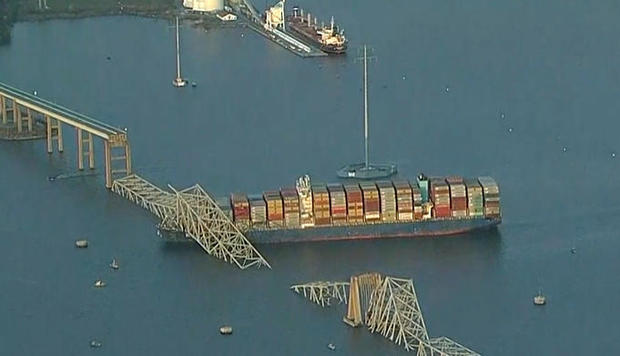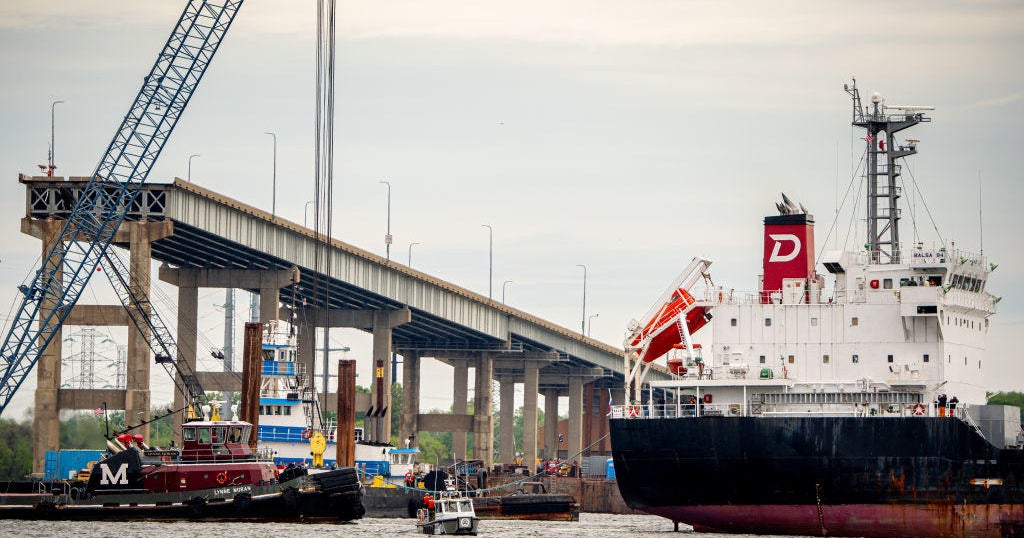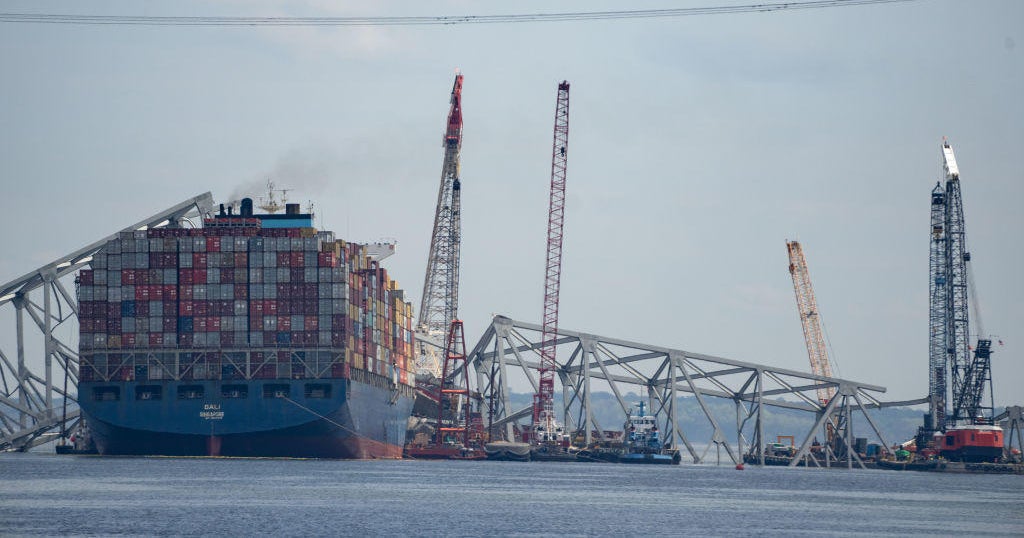What to know about the Francis Scott Key Bridge collapse in Baltimore that left 6 presumed dead
Search and rescue operations shifted to a recovery effort Tuesday night in Baltimore after a massive cargo ship lost power and struck the city's iconic Francis Scott Key Bridge early Tuesday, causing part of the bridge to collapse into the Patapsco River. The collapse sent people and vehicles into the water along with a stretch of the bridge itself.
Authorities said six people were presumed dead, and the bodies of two victims were recovered Wednesday.
Two people were recovered from the water soon after the collapse, one uninjured and one who was hospitalized and later released. All of them were part of a construction crew that was working on the bridge filling potholes at the time of the collapse.
Here is what we know so far.
What happened to the Key Bridge?
An enormous cargo vessel slammed into a support column of the sprawling Francis Scott Key Bridge, which runs for more than 57,000 feet over a stretch of the Patapsco River through central Baltimore, at about 1:30 a.m. ET Tuesday morning.
The impact caused a huge section of the bridge to collapse into the water. CBS Baltimore's Amy Kawata shared a harrowing video of the Key Bridge collapsing on social media.
A witness told CBS News Baltimore that the sound of the crash was massive and shook his home.
"Earthquake — sounded like a big bash of thunder," the man said. "And then just like I said it felt like an earthquake, the whole house vibrated. Like my house was falling down."
The first 911 calls came in at around 1:30 a.m. to report a ship hitting the bridge column, the Baltimore Fire Department told CBS News. Kevin Cartwright, the fire department's communications director, described it as a "mass casualty event."
Shipping traffic was suspended at the port after the collision, and I-695 is closed in both directions.
What caused the crash?
The ship involved in the crash, a Singapore-flagged vessel called the Dali, had just left the Port of Baltimore when it reported losing propulsion before crashing into the bridge support. Officials said the crew issued a mayday call, which gave them time to stop traffic from entering the bridge.
Baltimore Mayor Brandon Scott told CBS News that the mayday call "saved many lives" and allowed emergency personnel to get to the scene quickly.
Both Scott and Maryland Governor Wes Moore declared states of emergency in response to the collapse. Federal, state and local officials from agencies including the FBI and the National Transportation Safety Board headed to the scene.
Maryland Department of Transportation Secretary Paul Widefield said at an early briefing that the FBI was on the scene "to see if there was any terrorism connection, which there is not." He said the FBI's involvement is a precaution is common in the early stages of investigations.
"There is no specific or credible information to suggest there are ties to terrorism in this incident," said William J. DelBagno, the special agent in charge of the FBI's Baltimore field office, during a press conference later Tuesday morning.
"We are still investigating what happened, but we are quickly gathering details," said Gov. Moore at a news conference. "The preliminary investigation points to an accident. We haven't seen any credible evidence of a terrorist attack."
Homeland Security Secretary Alejandro Mayorkas said earlier on social media that his office was "closely monitoring the tragic situation" and added that there are "no indications that this was an intentional act."
Meanwhile, the National Transportation and Safety Board deployed a team to investigate the bridge collapse. A spokesperson for the agency told CBS News Baltimore on Wednesday that they had collected the data recorder onboard the ship to review and analyze what happened before its collision with the bridge. The NTSB will use that data recorder to come up with a timeline of events leading up to the incident, the spokesperson said, adding that the agency still needs to verify that the Dali lost power before striking that column.
An unclassified memo issued by CISA, the Cybersecurity and Infrastructure Security Agency, said the ship reported losing propulsion as it was leaving Baltimore Harbor and notified the Maryland Department of Transportation that a collision with the bridge was possible as they had lost control of the vessel.
"If it lost steering and power, then basically it's a dead ship just being carried by the current or its own momentum," James Mercante, the president of the New York Board of Pilot Commissioners, told CBS News.
The Dali was moving toward the bridge at a speed of about 8 knots, which authorities acknowledged was "very rapid."
"It would take quite a while — probably the length of five [or] six football fields — to bring that ship to a stop, even after dropping the anchors, because of its power and momentum. This is a behemoth," Mercante said.
Widefield said the overnight maintenance work "had nothing at all to do" with any structural issue impacting the bridge itself.
The most recent federal inspection report for the Francis Scott Key Bridge, filed in May 2022, gave the bridge span a score of 6 out of 9, which is considered "fair," CBS News Baltimore station WJZ reported. The Key Bridge had been in "fair" condition — a passing grade — since 2008, but the latest inspection report did note concerns over one of its reinforced concrete columns. The column's health index score was downgraded. It is unknown whether the column of concern was the same one that was struck on Tuesday morning.
Search and recovery mission
A search and recovery mission was forging ahead Wednesday morning as crews probed a debris field at the bottom of the river using a remotely operated vehicle, or ROV, looking for sunken vehicles or human remains. FBI Supervisory Special Agent Brian Hudson, the agent in charge of the search, said conditions underwater were dangerous and noted that debris had not yet settled.
"It's not a great spot for divers. It's incredibly black water, as the sediment gets kicked up, and there's also a significant current underwater as the tides change," Hudson said Wednesday on "CBS Morning." The search crew will primarily use an ROV with sonar technology, instead of a dive team, until they believe they have found something.
Hudson said the team has searched the length of the collapsed bridge span and by Wednesday had expanded their search area past those bounds by several hundred feet. They were told the search could take up to a week, he added.
The U.S. Coast Guard was actively searching for missing people throughout the day on Tuesday, but announced in the evening that it was shifting to a recovery effort.
"Based on the length of time that we've gone in this search, the extensive search efforts that we've put into it, the water temperature — that at this point we do not believe that we're going to find any of these individuals still alive," U.S. Coast Guard Rear Admiral Shannon N. Gilreath said.
Baltimore City Fire Chief James Wallace said at an earlier briefing that responders had pulled two survivors from the river, but six were believed missing.
One of the people rescued was not hurt and the other had "very serious" injuries, Wallace said. The individual with injuries was transported to University of Maryland Medical Center for treatment. The medical center's shock trauma department confirmed Tuesday afternoon that the person treated there had been discharged, WJZ's Caroline Foreback reported.
Officials said everyone known to be missing in the wake of the collapse was part of the construction crew working on the bridge when the ship crashed into it. They were from Guatemala, El Salvador, Honduras and Mexico, mostly in their 30s and 40s, and have spouses and children in Dundalk and Highlandtown, the Baltimore Banner reports.
Bodies of two were recovered on Wednesday, before officials said it became too hazardous and they had to turn to removing debris.
A senior executive at the company that employed the workers said Tuesday afternoon that the six were presumed dead, given the water's depth and the length of time since the crash, according to The Associated Press.
"This was so completely unforeseen," Jeffrey Pritzker, executive vice president of Brawner Builders, told AP. "We don't know what else to say."
Sonar had detected vehicles beneath the surface of the river, according to the fire chief. Meanwhile, crew members were still on board the vessel.
Water in the Patapsco was 48 degrees Fahrenheit overnight, according to the National Oceanic and Atmospheric Administration. Experts warn that submersion in waters at this temperature is extremely dangerous without proper protective gear, even for relatively short periods of time.
State authorities said that the portion of the river where the bridge collapsed is about 50 feet deep.
What type of bridge is it?
The Francis Scott Key Bridge features steel arches and is one of the longest continuous truss bridges in the world, according to the American Society of Civil Engineers.
Construction on the Francis Scott Key Bridge began in 1972, and it opened to traffic on March 23, 1977. Originally known as the Outer Harbor Crossing, the bridge is named after Francis Scott Key, the composer of the "Star-Spangled Banner."
According to the Maryland Transportation Authority, "Scholars believe the span crosses within 100 yards of the site where Francis Scott Key witnessed the bombardment of Fort McHenry on the evening of Sept. 12, 1814," a battle that inspired him to write what became the national anthem.
The span over the Patapsco River is 1.6 miles long. Including its connecting approaches, the full bridge project is 10.9 miles in length. For decades it served as a daily commute route for tens of thousands of people.
The Patapsco is a 39-mile river that weaves through central Maryland into the Chesapeake Bay. Part of the waterway forms the harbor in Baltimore and directly serves the city's main port, which is a major domestic and international shipping hub that is especially vital to the shipping network along the East Coast of the U.S.
Economic fallout
Job security could be in jeopardy for more than 10,000 people who are directly employed by the Port of Baltimore now that the bridge is out of commission. In addition to those direct employees, Gov. Moore has estimated that the port indirectly employs another 140,000 people.
Moore pledged to "take care of the workers" during an interview Wednesday on "CBS Mornings," where he also acknowledged the potentially crippling and far-reaching economic consequences of the collapse. The Baltimore port is one of the largest in the U.S. and a leading export point for the automotive industry.
"This port, and the economic impact of the port, is not just huge on the state of Maryland. This port is responsible for over 51 million tons of foreign cargo, the largest in the country," Moore told "CBS Mornings."
"So this is not just going to have a massive economic impact on the state of Maryland, this is going to hurt the farmer in Kentucky, it's going to hurt the auto dealer in Michigan," he said. "This is going to impact the entire country's economy. So it's imperative that we not just be smart, and that we're coordinated, and that were compassionate, but also we've got to get this done to completion and we've got to get it done together."
Where did the cargo vessel come from?
The 948-foot container ship, called Dali, was departing Baltimore and headed toward Colombo, the capital of Sri Lanka, when it crashed, the MidAtlantic Coast Guard told CBS News.
The vessel is time-chartered by the Danish shipping giant Maersk and operated by Synergy Marine Group, a charter vessel company. The Singapore-based company Grace Ocean Private owns the ship. Synergy said in a statement that it had activated its own incident response team and was "fully cooperating with Federal and State govenrment agencies under an approved plan." It said two pilots were steering the Dali, although it could not yet provide their names.
There were 22 crew members, including two pilots, aboard the ship, who are are all Indian nationals, Synergy said.
In a separate statement, Maersk said it "horrified by what has happened in Baltimore" and "closely following the investigations conducted by authorities and Synergy." No Maersk personnel or crew were on the ship during the collision, the company said, but the Dali was carrying cargo for Maersk customers.
Synergy's statement suggested there was no record of pollution into the river from the crash, but the fire department in Baltimore said on its scanner that there was a lot of diesel fuel seen in the water around the cargo ship. Exactly how much fuel had leaked into the water was still unclear Tuesday morning, the fire chief said. CISA noted in their memo that the agency had not received any reports of significant pollution into the river.
—Nicole Sganga, Kerry Breen, Brian Dakss and CBS News and CBS News Baltimore staff contributed reporting.




